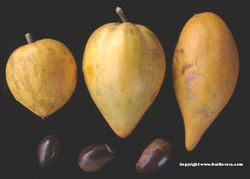Pouteria campechiana
| Pouteria campechiana subsp. var. | ||||||||||||||||||||||||||||||||||||||||||||||||||||||||
|---|---|---|---|---|---|---|---|---|---|---|---|---|---|---|---|---|---|---|---|---|---|---|---|---|---|---|---|---|---|---|---|---|---|---|---|---|---|---|---|---|---|---|---|---|---|---|---|---|---|---|---|---|---|---|---|---|

|
|
| ||||||||||||||||||||||||||||||||||||||||||||||||||||||
| ||||||||||||||||||||||||||||||||||||||||||||||||||||||||
| Standard Cyclopedia of Horticulture |
|---|
|
Lucuma nervosa, A. DC. (L. Rivicoa var. angustifolia, Miq.). Ti-Es. Egg-Fruit. Canistel. Fig. 2214. A small tree, 10-25 ft. high, with spreading branches: lvs. oblong- obovate to oblanceolate, 4-8 in. long, glabrous, bright green, acute: calyx-lobes 5, the inner ones rounded at the apex: corolla whitish, lobes ovate; style columnar, stigma slightly dilated; ovary 5-celled: fr. globose to ovoid, orange-yellow, 2-4 in. long, usually 2- or 3-seeded. A native of N. S. Amer., but cult, in other parts of Trop. Amer., naturalized on some of the Florida keys.
|
| Canistel {{{status}}} Fossil range: {{{fossil_range}}}
| ||||||||||||||||||||||||||||||||||||||||||||||||||||||||||||||||||
|---|---|---|---|---|---|---|---|---|---|---|---|---|---|---|---|---|---|---|---|---|---|---|---|---|---|---|---|---|---|---|---|---|---|---|---|---|---|---|---|---|---|---|---|---|---|---|---|---|---|---|---|---|---|---|---|---|---|---|---|---|---|---|---|---|---|---|
 | ||||||||||||||||||||||||||||||||||||||||||||||||||||||||||||||||||
| Plant Info | ||||||||||||||||||||||||||||||||||||||||||||||||||||||||||||||||||
| ||||||||||||||||||||||||||||||||||||||||||||||||||||||||||||||||||
| Scientific classification | ||||||||||||||||||||||||||||||||||||||||||||||||||||||||||||||||||
| ||||||||||||||||||||||||||||||||||||||||||||||||||||||||||||||||||
| [[{{{diversity_link}}}|Diversity]] | ||||||||||||||||||||||||||||||||||||||||||||||||||||||||||||||||||
| {{{diversity}}} | ||||||||||||||||||||||||||||||||||||||||||||||||||||||||||||||||||
| Binomial name | ||||||||||||||||||||||||||||||||||||||||||||||||||||||||||||||||||
| Pouteria campechiana Baehni | ||||||||||||||||||||||||||||||||||||||||||||||||||||||||||||||||||
| Trinomial name | ||||||||||||||||||||||||||||||||||||||||||||||||||||||||||||||||||
| {{{trinomial}}} | ||||||||||||||||||||||||||||||||||||||||||||||||||||||||||||||||||
| Type Species | ||||||||||||||||||||||||||||||||||||||||||||||||||||||||||||||||||
| {{{type_species}}} | ||||||||||||||||||||||||||||||||||||||||||||||||||||||||||||||||||
| {{{subdivision_ranks}}} | ||||||||||||||||||||||||||||||||||||||||||||||||||||||||||||||||||
| [[Image:{{{range_map}}}|{{{range_map_width}}}|]] | ||||||||||||||||||||||||||||||||||||||||||||||||||||||||||||||||||
| Synonyms | ||||||||||||||||||||||||||||||||||||||||||||||||||||||||||||||||||
| {{{synonyms}}} |
The Canistel (Pouteria campechiana) is an evergreen tree found from Mexico to Brazil. Its binomial name is derived from the Mexican town of Campeche, where it is native. It is sometimes (wrongly) referred to as Lucuma campechiana.
The canistel grows up to 10 m high, and produces orange-yellow fruits, up to 7 cm long, which are edible raw. Canistel flesh is sweet, with a texture often compared to that of a cooked egg yolk, hence its colloquial name of "eggfruit." It is closely related to the Mamey sapote and abiu.
The plant's name in Vietnamese is cây trứng gà (“chicken egg” plant) because of the appearance of the fruit. It also has been given the Vietnamese name lekima. This is very unusual because Vietnamese is a tonal language with monosyllables. It appears that the name derives from the word lucuma. Lekima made it to the list of typhoons, devastated north central Vietnam and killed from 42 to 55 people in Viet Nam on 10-03-2007.
References and links
http://www.nytimes.com/reuters/world/international-vietnam-floods.html?ref=world
Template:Fruit-tree-stub
Template:Fruit-stub
The fruit is loaded with vitamins and minerals such as vitamin B and vitamin A. It also contains little calories.